Third Party Observations/Demonstrations
Added on 2022-08-24
44 Pages6598 Words21 Views
Third Party Observations/Demonstrations
Learner’s name
Assessor’s name
Unit of Competence
(Code and Title)
BSBWHS501: Ensure a safe workplace
Assessment Third party
Due date of assessment
Third party’s name
Third party’s position
Third party’s relation to learner
Name of workplace
Third party’s telephone and
email
Learner’s name
Assessor’s name
Unit of Competence
(Code and Title)
BSBWHS501: Ensure a safe workplace
Assessment Third party
Due date of assessment
Third party’s name
Third party’s position
Third party’s relation to learner
Name of workplace
Third party’s telephone and
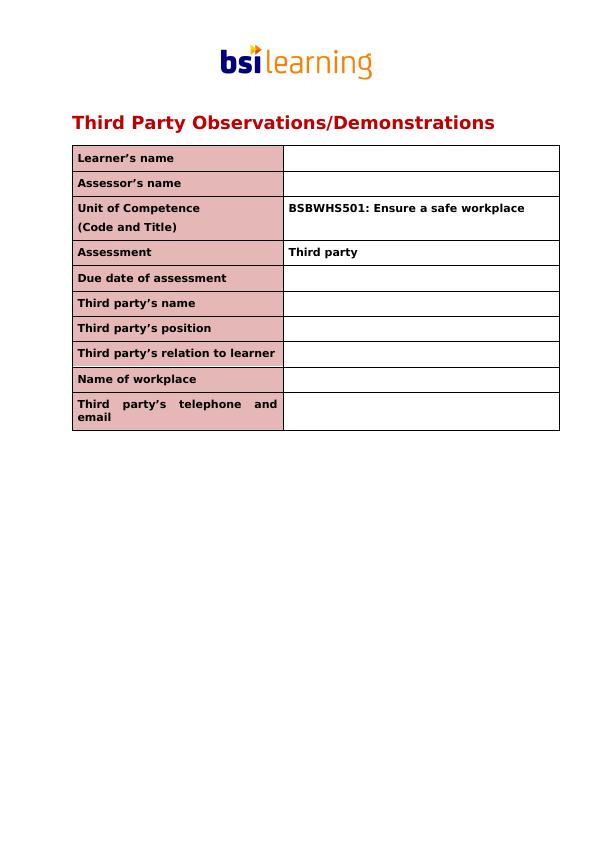
P a g e | 1
Part 1 – Preliminary questions for the third party
What is your relationship to
the learner?
How long have you worked
with the learner?
How closely do you work with
the learner in the area being
assessed?
What is your technical
experience and/or
qualification (s) in the area
being assessed? (Include any
assessment or training
qualifications.)
In your opinion, does the
learner:
Perform tasks to the
industry standards?
Manage job tasks
effectively?
Implement safe working
practices?
Solve problems on the job?
Work well with others?
Adapt to new tasks?
Adapt to unusual or non-
routine situations?
(Please circle yes
or no)
Do you understand which evidence/tasks the learner has Yes
No
provided/performed that you are required to comment on?
Has the assessor explained the purpose of the learner’s
Yes No
assessment?
Part 1 – Preliminary questions for the third party
What is your relationship to
the learner?
How long have you worked
with the learner?
How closely do you work with
the learner in the area being
assessed?
What is your technical
experience and/or
qualification (s) in the area
being assessed? (Include any
assessment or training
qualifications.)
In your opinion, does the
learner:
Perform tasks to the
industry standards?
Manage job tasks
effectively?
Implement safe working
practices?
Solve problems on the job?
Work well with others?
Adapt to new tasks?
Adapt to unusual or non-
routine situations?
(Please circle yes
or no)
Do you understand which evidence/tasks the learner has Yes
No
provided/performed that you are required to comment on?
Has the assessor explained the purpose of the learner’s
Yes No
assessment?

P a g e | 2
Are you aware that the learner will see a copy of this form?
Yes No
Are you willing to be contacted should further verification of this Yes
No
statement be required?
Are you aware that the learner will see a copy of this form?
Yes No
Are you willing to be contacted should further verification of this Yes
No
statement be required?
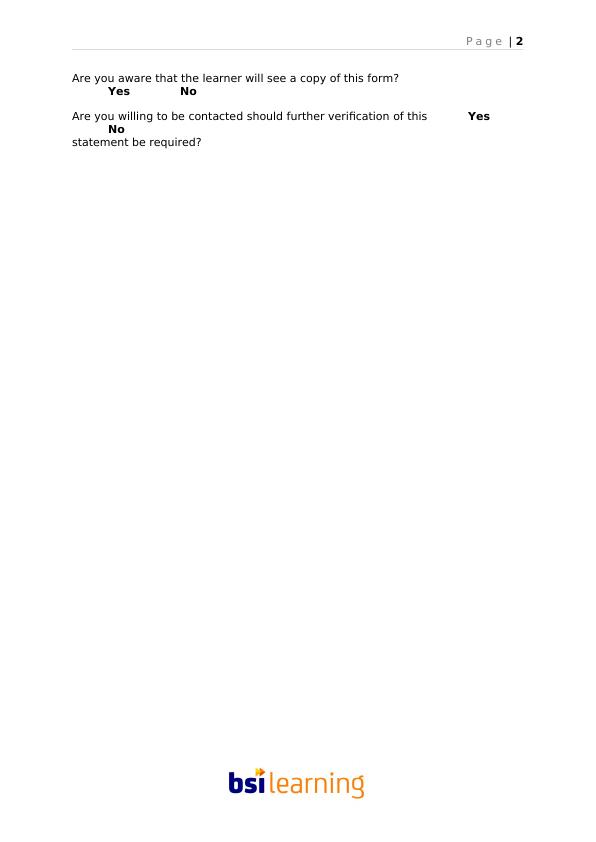
P a g e | 3
Part 2 – Main questions for the third party
Please indicate the type of evidence the learner has
provided you with for each criteria:
Direct – such as an observation of workplace performance by an
assessor
Indirect – such as a portfolio of evidence
Supplementary – such as supervisor reports.
Please indicate if your observations were real-time (in the workplace) or
simulated (demonstrations in a simulated environment).
Please provide your response, based on your observation
(direct/indirect/supplementary) in the area marked below – attach an additional
sheet(s) if required. In responding, please make sure to specify the manner of
observation and address the following, to the extent appropriate:
What did the learner do?
When did s/he do it?
When or over what period of time did s/he do it?
How did s/he do it?
What was the outcome?
Remember, as a third party, your information should be purely factual and not
represent your opinion on the learner’s competency.
Part 2 – Main questions for the third party
Please indicate the type of evidence the learner has
provided you with for each criteria:
Direct – such as an observation of workplace performance by an
assessor
Indirect – such as a portfolio of evidence
Supplementary – such as supervisor reports.
Please indicate if your observations were real-time (in the workplace) or
simulated (demonstrations in a simulated environment).
Please provide your response, based on your observation
(direct/indirect/supplementary) in the area marked below – attach an additional
sheet(s) if required. In responding, please make sure to specify the manner of
observation and address the following, to the extent appropriate:
What did the learner do?
When did s/he do it?
When or over what period of time did s/he do it?
How did s/he do it?
What was the outcome?
Remember, as a third party, your information should be purely factual and not
represent your opinion on the learner’s competency.
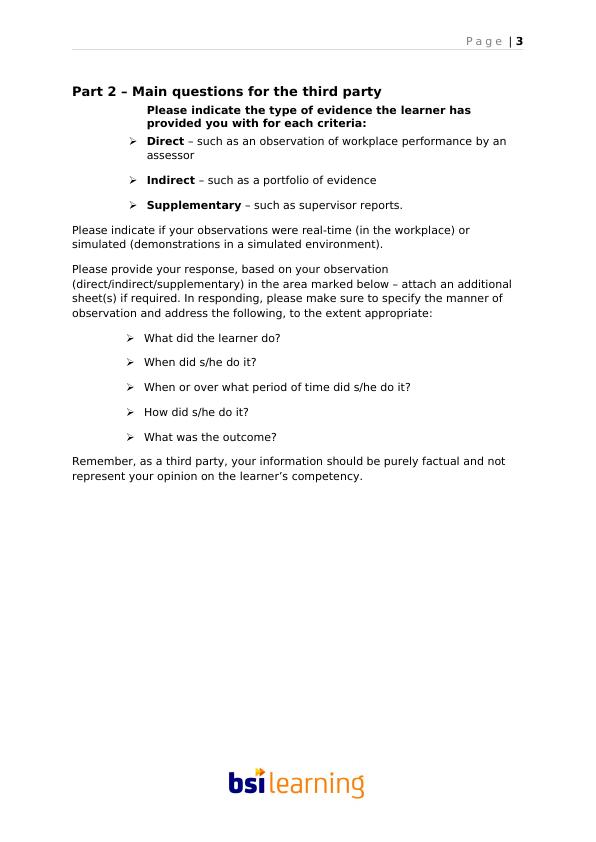
P a g e | 4
Third party observation
Tasks Third party response based on
observation
(direct/indirect/supplementary – please
indicate)
1. Locate, adapt, adopt and
communicate WHS policies that
clearly define the organisation’s
commitment to complying with
WHS legislation
Learners should:
Successfully identify the
locations of WHS policies and
relevant WHS information
Adopt existing policies and
make adaptations as
necessary, considering the
requirements of employees
in different departments and
work areas
Use appropriate methods for
the communication of WHS
policies.
Type of observation/evidence:
indirect
What did the learner do?
Submitted a report
When did s/he do it? Over what period of time?
Audit of the policies
How did s/he do it?
Analysing the workplace
What was the outcome?
Positive outcome
Other relevant comments/evidence:
no
2. Identify duty holders and define
WHS responsibilities for all
workplace personnel in the work
area according to WHS
legislation, policies, procedures
and programs
Identify the different types
and responsibilities of duty
holders within their
organisations
Identify the WHS
responsibilities which are
specified within legislation,
policies, procedures, and
programs.
Type of observation/evidence:
Supplementary
What did the learner do?
Observation workplace
When did s/he do it? Over what period of time?
Evaluate
How did s/he do it?
Audit
What was the outcome?
Positive
Other relevant comments/evidence:
Third party observation
Tasks Third party response based on
observation
(direct/indirect/supplementary – please
indicate)
1. Locate, adapt, adopt and
communicate WHS policies that
clearly define the organisation’s
commitment to complying with
WHS legislation
Learners should:
Successfully identify the
locations of WHS policies and
relevant WHS information
Adopt existing policies and
make adaptations as
necessary, considering the
requirements of employees
in different departments and
work areas
Use appropriate methods for
the communication of WHS
policies.
Type of observation/evidence:
indirect
What did the learner do?
Submitted a report
When did s/he do it? Over what period of time?
Audit of the policies
How did s/he do it?
Analysing the workplace
What was the outcome?
Positive outcome
Other relevant comments/evidence:
no
2. Identify duty holders and define
WHS responsibilities for all
workplace personnel in the work
area according to WHS
legislation, policies, procedures
and programs
Identify the different types
and responsibilities of duty
holders within their
organisations
Identify the WHS
responsibilities which are
specified within legislation,
policies, procedures, and
programs.
Type of observation/evidence:
Supplementary
What did the learner do?
Observation workplace
When did s/he do it? Over what period of time?
Evaluate
How did s/he do it?
Audit
What was the outcome?
Positive
Other relevant comments/evidence:
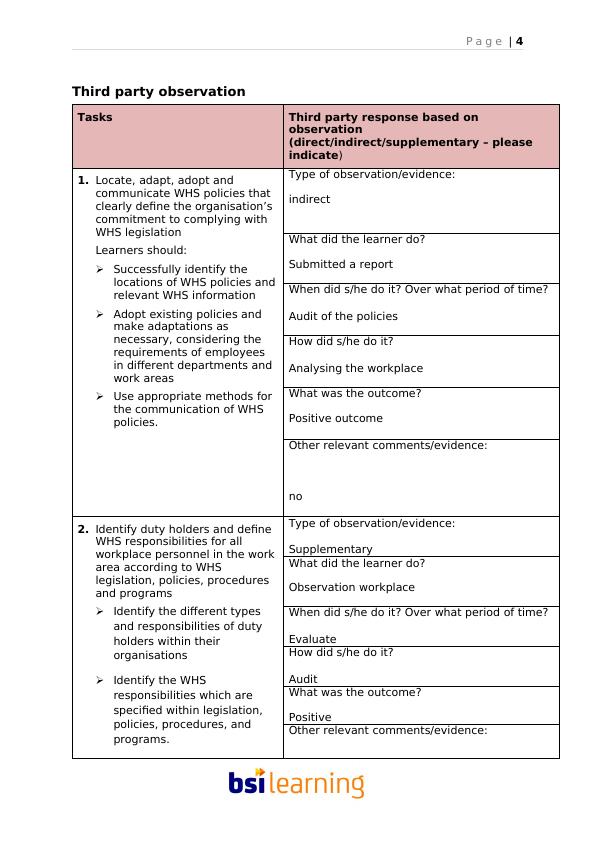
P a g e | 5
No
3. Identify and approve financial
and human resources required
by the WHS management
system (WHSMS)
Learners should:
Identify various requirements
of the WHS management
system and ensure that
finances and human
resources are allocated
accordingly.
Type of observation/evidence:
Indirect
What did the learner do?
Audit report
When did s/he do it? Over what period of time?
Analyse
How did s/he do it?
Company audit report
What was the outcome?
Positive
Other relevant comments/evidence:
no
4. Work with workers and their
representatives to set up and
maintain participation
arrangements according to
relevant WHS legislation
Learners should:
Implement appropriate
consultation and
participation processes in
accordance with
organisational procedures.
Type of observation/evidence:
Indirect
What did the learner do?
Work
When did s/he do it? Over what period of time?
Office shift
How did s/he do it?
What was the outcome?
Other relevant comments/evidence:
No
3. Identify and approve financial
and human resources required
by the WHS management
system (WHSMS)
Learners should:
Identify various requirements
of the WHS management
system and ensure that
finances and human
resources are allocated
accordingly.
Type of observation/evidence:
Indirect
What did the learner do?
Audit report
When did s/he do it? Over what period of time?
Analyse
How did s/he do it?
Company audit report
What was the outcome?
Positive
Other relevant comments/evidence:
no
4. Work with workers and their
representatives to set up and
maintain participation
arrangements according to
relevant WHS legislation
Learners should:
Implement appropriate
consultation and
participation processes in
accordance with
organisational procedures.
Type of observation/evidence:
Indirect
What did the learner do?
Work
When did s/he do it? Over what period of time?
Office shift
How did s/he do it?
What was the outcome?
Other relevant comments/evidence:
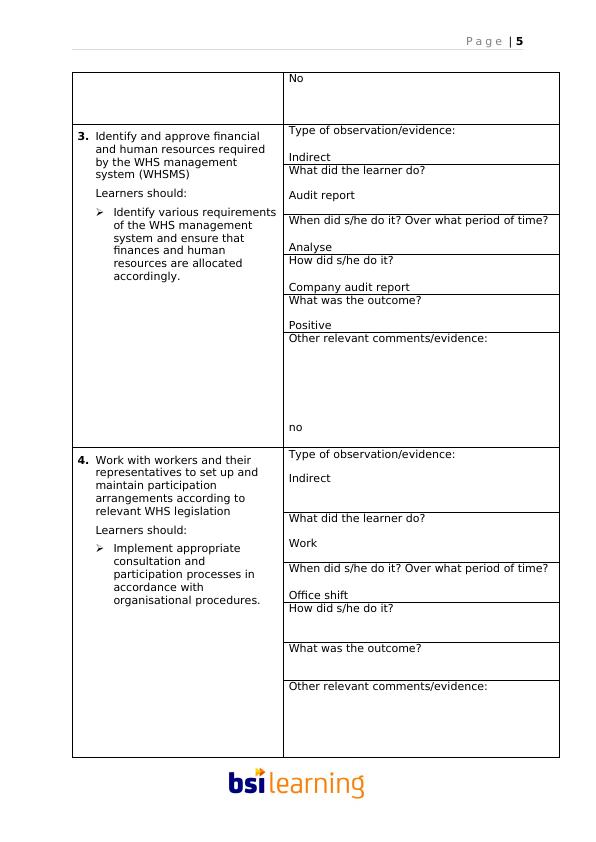
P a g e | 6
5. Appropriately resolve issues
raised through participation and
consultation arrangements
according to relevant WHS
legislation
Learners should:
Successfully resolve WHS
issues in accordance with
relevant legislation and
organisational procedures.
Type of observation/evidence:
Direct
What did the learner do?
Consultation
When did s/he do it? Over what period of time?
Survey
How did s/he do it?
Questionnaire to the employees
What was the outcome?
Negative
Other relevant comments/evidence:
No
6. Promptly provide information
about the outcomes of
participation and consultation to
workers and ensure it is easy for
them to access and understand
Learners should:
Use appropriate forms of
communication and ensure
that employees are provided
with relevant details about
the outcomes of participation
and consultation.
Type of observation/evidence:
Indirect
What did the learner do?
Monitor
When did s/he do it? Over what period of time?
Office shift
How did s/he do it?
Emails, survey outcome
What was the outcome?
Negative
Other relevant comments/evidence:
no
5. Appropriately resolve issues
raised through participation and
consultation arrangements
according to relevant WHS
legislation
Learners should:
Successfully resolve WHS
issues in accordance with
relevant legislation and
organisational procedures.
Type of observation/evidence:
Direct
What did the learner do?
Consultation
When did s/he do it? Over what period of time?
Survey
How did s/he do it?
Questionnaire to the employees
What was the outcome?
Negative
Other relevant comments/evidence:
No
6. Promptly provide information
about the outcomes of
participation and consultation to
workers and ensure it is easy for
them to access and understand
Learners should:
Use appropriate forms of
communication and ensure
that employees are provided
with relevant details about
the outcomes of participation
and consultation.
Type of observation/evidence:
Indirect
What did the learner do?
Monitor
When did s/he do it? Over what period of time?
Office shift
How did s/he do it?
Emails, survey outcome
What was the outcome?
Negative
Other relevant comments/evidence:
no
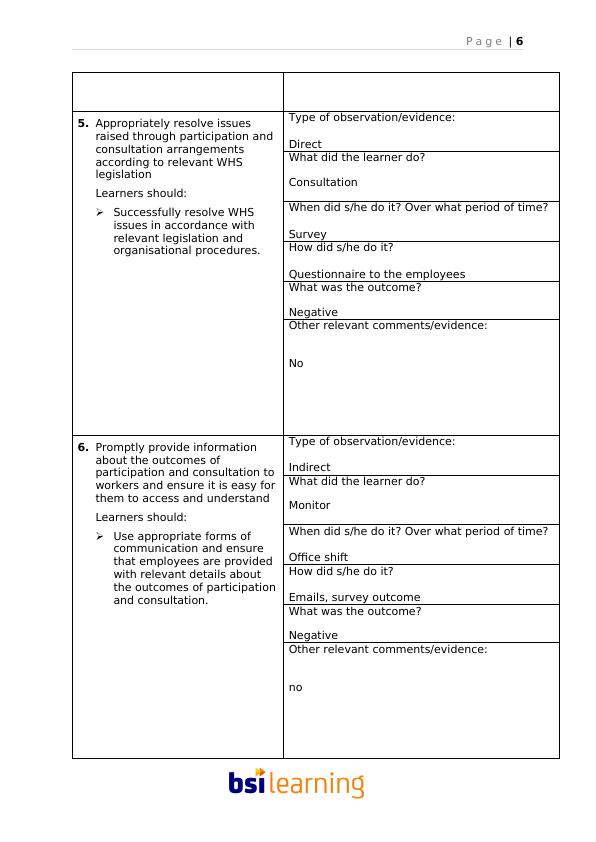
P a g e | 7
7. Develop procedures for ongoing
hazard identification, and
assessment and control of
associated risks
Learners should:
Identify a range of hazards in
accordance with
organisational procedures
Use a range of assessment
methods to establish the
levels of risk associated with
identified hazards
Control identified risks using
the hierarchy of risk control
as appropriate.
Type of observation/evidence:
Indirect
What did the learner do?
Monitor
When did s/he do it? Over what period of time?
After reviewing the policies
How did s/he do it?
Develop procedures for ongoing hazard
identification, and assessment and control of
associated risks
What was the outcome?
Negative
Other relevant comments/evidence:
No
8. Include hazard identification at
the planning, design and
evaluation stages of any change
in the workplace to ensure that
new hazards are not created by
the proposed changes and
existing hazards are controlled
Learners should:
Undertake hazard
identification processes and
identify a range of hazards
associated with projected
change in the workplace.
Type of observation/evidence:
What did the learner do?
When did s/he do it? Over what period of time?
How did s/he do it?
What was the outcome?
Other relevant comments/evidence:
7. Develop procedures for ongoing
hazard identification, and
assessment and control of
associated risks
Learners should:
Identify a range of hazards in
accordance with
organisational procedures
Use a range of assessment
methods to establish the
levels of risk associated with
identified hazards
Control identified risks using
the hierarchy of risk control
as appropriate.
Type of observation/evidence:
Indirect
What did the learner do?
Monitor
When did s/he do it? Over what period of time?
After reviewing the policies
How did s/he do it?
Develop procedures for ongoing hazard
identification, and assessment and control of
associated risks
What was the outcome?
Negative
Other relevant comments/evidence:
No
8. Include hazard identification at
the planning, design and
evaluation stages of any change
in the workplace to ensure that
new hazards are not created by
the proposed changes and
existing hazards are controlled
Learners should:
Undertake hazard
identification processes and
identify a range of hazards
associated with projected
change in the workplace.
Type of observation/evidence:
What did the learner do?
When did s/he do it? Over what period of time?
How did s/he do it?
What was the outcome?
Other relevant comments/evidence:

End of preview
Want to access all the pages? Upload your documents or become a member.
Related Documents
BSBWHS401 Implement and Monitor WHS policies and Procedureslg...
|81
|10891
|590
Provide Support to People Living with Dementia - CHCAGE005lg...
|18
|3995
|465
CHCCCS011 Learner Workbook - Desklib Online Librarylg...
|41
|9675
|136
CHCECE018 Nurture Creativity in Children: Assessment Workbooklg...
|49
|10582
|333
Appeals Process, Recognised Prior Learning, Special Needslg...
|31
|7068
|245
HLTWHS004 Learner Workbook for Work Health and Safety Managementlg...
|53
|10591
|277
